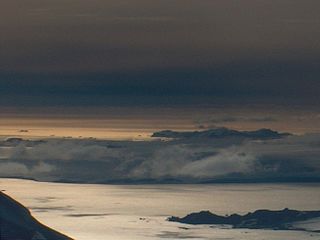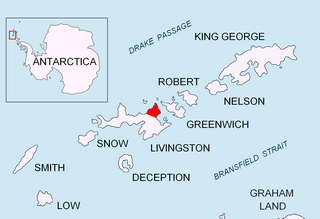
The Atlantic Club Ridge is a ridge rising to 161 m on Hurd Peninsula in Eastern Livingston Island, Antarctica. To the west the ridge surmounts the South Bay coast north of Johnsons Dock, to the south it is bounded by the lower course of the two km long Contell Glacier, to the east by the foot of the Balkan Snowfield sloping up towards Krum Rock and to the northwest by Sea Lion Tarn. The ridge is snow-free in the summer months.

Bulgarian Beach is a coast in the north part of Hurd Peninsula, eastern Livingston Island, extending 2.3 km from Hespérides Point to the southwest to Perunika Glacier to the northeast, and forming the southeast coast of Emona Anchorage.

Kresna Gully is a heavily crevassed depression in Perunika Glacier extending 2.25 km westwards from Rezen Knoll in eastern Livingston Island in the South Shetland Islands, Antarctica. The gully ends in the indentation forming the east corner of Emona Anchorage, and located 3.15 km northeast of Hespérides Point 1.21 km south-southeast of Aleko Point.

Osogovo Bay, "named after the Osogovo region in western Bulgaria," is bounded by the south coast of Rugged Island, by Astor Island, and by the west coast of the Byers Peninsula south of Laager Point, Livingston Island in the South Shetland Islands, Antarctica.

Perunika Glacier is an 8 km long and 3 km wide (average) roughly crescent-shaped glacier in eastern Livingston Island in the South Shetland Islands, Antarctica situated east of Pimpirev Glacier, south of Saedinenie Snowfield, southwest of Kaliakra Glacier, west of Huron Glacier, and north of Balkan Snowfield and the head of Huntress Glacier.

Rezovski Creek is a meltwater stream located on Livingston Island, Antarctica.

Sea Lion Glacier is the site of an isolated 350 metres (1,150 ft) long glacier on Hurd Peninsula, eastern Livingston Island in the South Shetland Islands, Antarctica. It is located southwest of Hesperides Hill and northwest of Atlantic Club Ridge, separated from the latter by Sea Lion Tarn, and terminating on the South Bay coast.

Sinemorets Hill is the second most prominent in the chain of hills surmounting Bulgarian Beach in eastern Livingston Island in the South Shetland Islands, Antarctica.

Spanish Knoll has a highest point of elevation 48 m located on Bulgarian Beach on Hurd Peninsula, eastern Livingston Island in the South Shetland Islands, Antarctica.

Spanish Point is located on Bulgarian Beach on Hurd Peninsula, eastern Livingston Island in the South Shetland Islands, Antarctica formed by an offshoot of Spanish Knoll.

Vergilov Rocks are a group of rocks off Bulgarian Beach on Hurd Peninsula in eastern Livingston Island in the South Shetland Islands, Antarctica, consisting of one main rock and two adjacent smaller ones submerging at high water.

Balkan Snowfield is an ice-covered plateau of elevation ranging from 150 to 280 m in eastern Livingston Island in the South Shetland Islands, Antarctica, situated south of lower Perunika Glacier, northwest of Huntress Glacier and north of Contell Glacier. It is 3 km (1.9 mi) long in southwest-northeast direction and 2 km (1.2 mi), and bounded by Burdick Ridge to the east, Willan Nunatak and Castillo Nunatak to the southeast, and Krum Rock to the southwest. The feature slopes gently northwestwards with its foot bounded by the hills along Bulgarian Beach. It is named after the Balkans.

New Plymouth is a bay bordered by an extensive line of beaches, lying south of Start Point and between Rugged Island and the west end of Livingston Island in the South Shetland Islands, Antarctica.

Hespérides Point is a rocky point of land projecting into South Bay north-northwest of Johnsons Dock, Livingston Island in the South Shetland Islands, Antarctica and forming the southwest side of the entrance to Emona Anchorage. Surmounted by Hesperides Hill. The area was visited by 19th century sealers operating from nearby Johnsons Dock.

Johnsons Dock is a sheltered 500 m wide cove indenting for 900 m the northwest coast of Hurd Peninsula on Livingston Island in the South Shetland Islands, Antarctica. It is part of South Bay entered north of Ballester Point. Surmounted by Charrúa Ridge on the northeast. The cove was frequented by early 19th century sealers.

Johnsons Glacier is the 1.8 km long and 2.3 km wide glacier on Hurd Peninsula, Livingston Island in the South Shetland Islands, Antarctica bounded by Charrúa Ridge and Charrúa Gap to the north, Napier Peak to the east, Mirador Hill to the southeast, Hurd Ice Cap to the southwest and Mount Reina Sofía to the west. It is draining northwestwards into Johnsons Dock. The glacier provides overland access from the Spanish base Juan Carlos Primero to the interior of the eastern Livingston Island.

Window Island is a small ice-free island off the north coast of Ray Promontory in the northwest of Byers Peninsula, Livingston Island in the South Shetland Islands, Antarctica. The island has a surface area of 23 hectares and rises to 72 m (236 ft). It was known to the early 19th century sealers operating on Byers Peninsula.

Raquelia Rocks is a group of three adjacent rocks in eastern South Bay, Livingston Island in the South Shetland Islands, Antarctica formed by an offshoot of Atlantic Club Ridge halfway along the Zodiac boat route linking the Spanish Antarctic Base and the Bulgarian Antarctic Base on the island. The area was visited by early 19th century sealers operating from nearby Johnsons Dock.

Ojeda Beach is the ice-free beach extending 730 m on the southeast coast of South Bay, Hurd Peninsula on Livingston Island in the South Shetland Islands, Antarctica. It is bounded by Hespérides Point to the north, Hesperides Hill and Atlantic Club Ridge to the east, and Boeritsa Point to the south. The beach was possibly visited by early 19th century sealers frequenting the nearby Johnsons Dock.

Quiroga Ridge is a submarine ridge in False Bay, Livingston Island in the South Shetland Islands of Antarctica. It extends 2.2 km in an east-southeast to west-northwest direction between Ogosta Point on the Rozhen Peninsula and the opposite coast of Hurd Peninsula at a depth of over 50 m, with depths exceeding 100 m on both sides of the ridge. It was formed as a frontal moraine of Huntress Glacier between the 13th and 17th centuries.












